|
Sept. 10, 2019
FREE local workshops to be offered this fall (one day unless noted otherwise):
Sept. 16, 2019 (Monday) - 8:45 am – 4 pm, Washington County Cottage Grove Offices, Basic Floodplain and Shoreland Management Training
Sept. 24, 2019 (Tuesday) - 8:45 a.m. –4 p.m., Pope County Courthouse, Glenwood; Basic Floodplain and Shoreland Management Training
Oct. 3, 2019 (Thursday), Clay County Courthouse, Moorhead:
- 8:45 a.m.–4 p.m., Floodplain Training - Basic and Advanced topics
- 12:30–2:30 p.m., New Map FAQs for Local Officials & Professionals (surveyors, consulting engineers/planners, realtors, lenders, etc.)
Note: The New Map FAQs is targeted at Norman County, but others are welcome to attend.
Contact Ceil Strauss, 651-259-5713 or floodplain.dnr@state.mn.us for more details on topics to be covered or to RSVP for a training.
The Floodplain Training and Education page will be updated as training dates are confirmed.
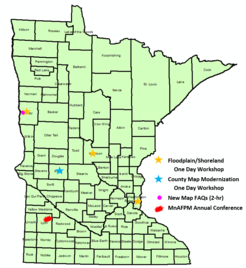
Types of workshops offered:
-
Basic Floodplain and Shoreland Workshop – A one-day workshop covering floodplain and shoreland basic and advanced topics. Two tracks are normally offered.
-
New Map FAQs – Two-hour workshop in counties with new FEMA maps going effective within a few months.
-
County Map Modernization Workshop - One-day workshop covering topics chosen by county as part of county map modernization process. All are welcome to attend.
|
By Beth Knudsen, MNDNR, Watershed Assessment Coordinator
The Watershed Health Assessment Framework (WHAF) is a map tool on the MNDNR website that delivers GIS data together with watershed boundaries and ecological health scores. With a couple clicks, you can:
- Explore different scale watersheds, from major river basin to local catchment.
- Access a wide range of GIS data to add to the map.
- Add health scores to see natural resource conditions across Minnesota.

This link opens the newest version of the WHAF Map App. The Map Help page and downloadable guide give helpful details on how to use the mapping application.
|
WHAF Map Interface
Click anywhere in Minnesota to set your location, then try the tools on the right side of the map:
-
Set Scale lets you zoom and mask to different watershed boundaries. Use the "select all" button to delineate nested watershed boundaries.
- Open Ecological Health Scores to map health scores for each of the "five components."
- Use Add Data to access an extensive list of layers to add to the map. Use the filters to search for layers of interest.
- Click Charts and Reports to access Land Cover Charts and link to Watershed Context Reports, Health Report Cards and Climate Summaries.
A New View of Historic Climate Data
The WHAF team recently worked with MN Climatology staff to summarize long-term historic precipitation and temperature data in new ways. Three new climate related products reveal patterns of change in Minnesota's climate at the statewide and major watershed scale.
-
Animated maps of annual and seasonal precipitation and temperature are a new way to view change over time.
Why is a shift in climate important for managing watershed health?
Natural processes evolve in response to local, regional and global climate conditions. If local climate measurements are showing a shift, other ecological processes will change in response. Communities and individuals making decisions about managing land and water resources for infrastructure, flood protection, habitat protection, water supply, and other needs need to be aware of this shift and consider its potential impacts.
Will the climate keep changing in this way?
Historic data can't answer that question; these are visualizations of the historic data and not a predictive model of future climate trends. You can read more about climate and climate trends on the DNR website.
Visit the Watershed Health Assessment Framework for more ways Minnesota is managing for watershed health.
Subscribe to the WHAF Newsletter to receive updates on the project.
FEMA has many National Flood Insurance Program (NFIP) Technical Bulletins that are helpful for understanding and interpreting NFIP requirements. Most of the technical bulletins are over a decade old, and several were released as far back as 1993. FEMA has been working on updates with its partners to update most of the bulletins. The first round of updates was recently released, including NFIP Technical Bulletins 0, 4 and 8.
Technical Bulletin 8, Corrosion Protection for Metal Connectors and Fasteners in Coastal Areas, is not applicable in Minnesota.
See links and a summary of FEMA NFIP Technical Bulletins applicable to Minnesota.
By Nicole Lehman, MNDNR, Area Hydrologist
Wet spring compounded by heavy rainfall in Rochester area
In 2019, Rochester precipitation from January 1 - August 31 is the second most on record (101 years of records) with 36.61 inches through August 21. The record is 38.69 inches from 1990. Much of this wet weather occurred in May (3.79 inches), June (4.4 inches) and July (2.83 inches).
The most dramatic storm event occurred on June 28, 2019, dropping 4.95 inches of rainfall at the Rochester airport with other local reports of 8.5 inches in SW Rochester (radar animation). Repeated thunderstorms re-formed over the area from a stalled weather front that submerged roads, caused a major Trunk Highway 52 road closure for nearly 24 hours south of Pine Island, and flooded airport runways. No deaths were reported. Despite the heavy rains and flooding, a Byron farmer who lost over 40 cattle due to flash flooding, including a video of the cattle floating down the river, was virtually the only flood coverage by the Twin Cities media.
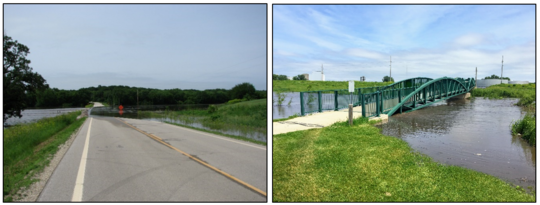
Left photo: Salem Creek overtopping County Road 3 on June 28. (Source: MNDNR). Right photo: Cascade Creek flooding at pedestrian bridge near Highways 14 and 52. (Source: Rochester Public Works)
Could the impacts of the June 28th rainfall have been worse?
Yes! The SE Minnesota flash flood of 1978 (July 5-6) dropped up to 7.3 inches of rainfall, which was estimated to be equivalent to a 175‑year event. According to the National Weather Service (NWS), “The area of a 4-inch rainfall covered an area of 700 square miles. The South Fork Zumbro River and its tributaries (Bear Creek, Silver Creek, Cascade Creek) flooded through Rochester causing extensive damage.” The South Fork Zumbro River hit an all-time record crest of 23.36’ (30,500 cfs); and another flash flood later in September, dropped 7.7 inches in less than 6 hours in downtown Rochester.
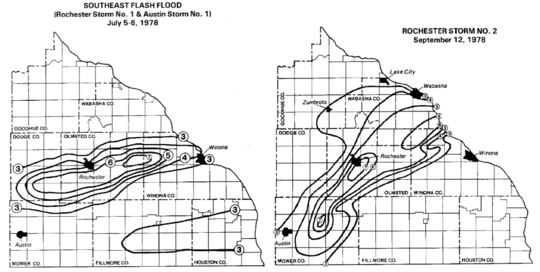
Rain distribution from July and September 1978 flash floods. Source: DNR Climatology Office
Rochester flood control project completed since 1978
While the city of Rochester was already working on flood control options, the 1978 event changed the designs from 100-year storm to 200-year storm and helped gather legislative support for the Natural Resources Conservation Service (NRCS) and US Army Corps of Engineers flood control projects. The city approved a 1% local sales tax referendum in 1982; and in 1983, the legislature approved Minnesota’s first location option sales tax.
The flood control project provides protection for a 200-year flood event and includes:
- Seven (7) reservoirs located on Silver Creek (1), Willow Creek (2), Bear Creek (1) and Cascade Creek (3) that retain 16% of floodwaters for a controlled 10-day release.
- An overly wide channel on the South Fork Zumbro and Bear Creek that was constructed through the City of Rochester and which provides a 200-year flood capacity.
The flood control project does its job
The overly wide portion of Bear Creek carried lots of water during the June 28th storm.

Bear Creek Drop Structure south of Highway 14 showing over widened channel during June 28th storm (left) and during baseflow (right). Source: Left to right, Rochester Public Works and MNDNR.
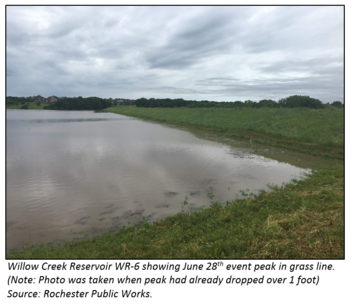
The flood control reservoirs - designed for a 24-inch rainfall in 6-hours without overtopping - tested the waters in the aftermath of the June 28, 2019, storm. Willow Creek Reservoir (WR-6) was 0.21 feet short of overtopping the spillway, the first time any Rochester reservoir has reached such levels according to the City of Rochester Public Works Manager, Matt Crawford.
|
Rochester Flood Control Project greatly reduces impacts
The rainfall distribution of the June 28th rainfall was equivalent to a 100-year event, and mirrored the 1978 flood, but resulted in much less impact to the downtown Rochester community where the majority of the populous resides. The Rochester Flood Control Project removed 2,000 homes and businesses from the official FEMA mapped floodplain and reduced flood insurance costs.
But more importantly, the proactive work on the flood control project prevented damage to those 2,000 plus homes and businesses and allowed business and life to proceed as usual! The estimated damage reduction benefit of this project is $250 million per 100-year event.
Note: Rochester Public Works and MNDNR Climatology Office contributed to this article.
See wetlands and public waters in interactive map
Want to see what’s shown on the National Wetlands Inventory (NWI) or see what’s in Minnesota’s Public Waters Inventory in a nice interactive map? Go to the DNR’s Wetland Finder Application to access the map. You can search for locations using a street address, water resource name, DNR basin ID number or township/range/section.
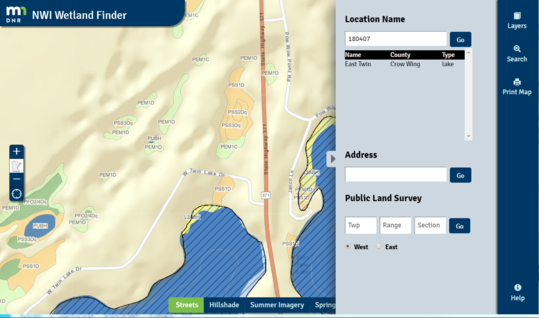
Figure showing example map of NWI wetlands and pubic waters (with cross-hatching) using default streets backgrounds
Note that while useful for planning purposes, these map data do not identify or define jurisdictional limits for any wetland regulatory program. These data are not a substitute for on the ground wetland identification and delineation.
See other wetland and public waters information and links on DNR’s Wetlands Maps page. Contact Steve Kloiber for additional information.
|